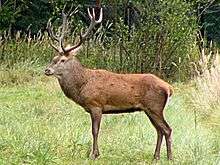Cervus
| Cervus | |
|---|---|
 | |
| Cervus elaphus | |
| Scientific classification | |
| Kingdom: | Animalia |
| Phylum: | Chordata |
| Class: | Mammalia |
| Order: | Artiodactyla |
| Family: | Cervidae |
| Subfamily: | Cervinae |
| Tribe: | Cervini |
| Genus: | Cervus Linnaeus, 1758 |
| Species | |
| |
Cervus is a genus of deer that primarily are native to Eurasia, although one species occurs in northern Africa and another in North America. In addition to the species presently placed in this genus, it has included a whole range of other species now commonly placed in other genera, but some of these should perhaps be returned to Cervus. Additionally, the species-level taxonomy is in a state of flux.
Taxonomy
Genus
Until the 1970s, Cervus also included the members of the genera Axis, Dama, Elaphurus and Hyelaphus, and until the late 1980s, it included members of Przewalskium, Rucervus and Rusa.[1] With the exception of the chital (Axis axis), barasinga (Rucervus duvaucelii), Schomburgk's deer (R. schomburgki), and members of the genus Dama, genetic evidence suggests all should be returned to Cervus.[2][3]
Species
In the third edition of Mammal Species of the World from 2005, only the red deer (C. elaphus) and sika deer (C. nippon) were recognized as species in the genus Cervus.[1] Genetic and morphological evidence suggest more species should be recognized.[2][3] For example, the subspecies C. e. canadensis (elk/wapiti) is considered by some to be a separate species.[4]
Red deer species group
Within the red deer species group, some sources have recommended the elk or wapiti (C. canadensis) and central Asian red deer should be treated as species.[2][4][5] If the central Asian red deer (from the Caspian Sea to western China) is recognized as a species, it includes the Yarkand deer and Bactrian deer (the two may be synonymous), but it could possibly also include the Kashmir stag, which has not been sampled in recent studies.[2][4] If it is included in the Central Asian Red Deer, the scientific name of that species is C. hanglu. If it is not included in the central Asian deer, the scientific name of that species is C. yarkandensis, and the Kashmir stag (C. hanglu) may represent a separate monotypic species.[2][4]
Others members of the red deer group, which may represent separate species, are C. corsicanus, C. wallichii and C. xanthopygus.[2][3] If so, C. corsicanus includes the subspecies C. c. barbarus (perhaps a synonym of corsicanus), and is restricted to Maghreb in North Africa, Corsica and Sardinia.[2][4] C. wallichii would probably include the subspecies C. w. kansuensis and C. w. macneilli (both are perhaps synonyms of C. w. wallichii), and would be found from Tibet to central China.[2][4][6] C. xanthopygus would probably include the subspecies C. x. alashanicus (perhaps a synonym of C. x. xanthopygus), and would be found from the Russian Far East to northeastern China.[2][4][6] This would restrict the "true" red deer (C. elaphus) to Europe, Anatolia, Caucasus and northwestern Iran, and the elk/wapiti (C. canadensis) to North America and the Asian regions of Tian Shan, Altai, and Great Khingan.[2] Alternatively, the barbarus group species are subspecies of the "true" red deer, while the C. wallichii and C. xanthopygus groups are subspecies of the elk/wapiti.[4]
Sika deer species group
The sika deer should be split into four species based on genetics, morphology and voice,[3] although this may be premature based on the presently available evidence.[7] If split, the potential species are C. yesoensis from northern and central Japan (Hokkaido, and northern and central Honshu), C. nippon of southern Japan (southern Honshu, Shikoku, Kyushu, Okinawa, Tsushima and other small islands), C. hortulorum of mainland Asia (Russian Far East, Korea, central and eastern China, and northern Vietnam), and C. taiouanus of Taiwan.[3]
References
- 1 2 Wilson, D.E.; Reeder, D.M., eds. (2005). Mammal Species of the World: A Taxonomic and Geographic Reference (3rd ed.). Johns Hopkins University Press. ISBN 978-0-8018-8221-0. OCLC 62265494.
- 1 2 3 4 5 6 7 8 9 10 Pitraa, Fickela, Meijaard, Groves (2004). Evolution and phylogeny of old world deer. Molecular Phylogenetics and Evolution'.' 33:880–895.
- 1 2 3 4 5 Groves (2006). The genus Cervus in eastern Eurasia. European Journal of Wildlife Research 52: 14–22.
- 1 2 3 4 5 6 7 8 Ludt, C.J.L; Schroeder, Rottmann and Kuehn (2004). Mitochondrial DNA phylogeography of red deer (Cervus elaphus). Molecular Phylogenetics and Evolution 31: 1064–1083.
- ↑ Randi, Mucci, Claro-Hergueta, Bonnet and Douzery (2001). A mitochondrial DNA control region phylogeny of the Cervinae: speciation in Cervus and implications for conservation. Anim. Conserv. 4: 1–11.
- 1 2 Smith and Xie, editors (2008). Mammals of China. ISBN 978-0-691-09984-2
- ↑ Harris, R.B. (2008). "Cervus nippon". IUCN Red List of Threatened Species. Version 2010.4. International Union for Conservation of Nature. Retrieved 11 March 2011.
External links
| Wikimedia Commons has media related to Cervus. |